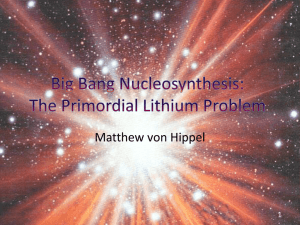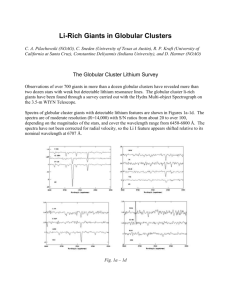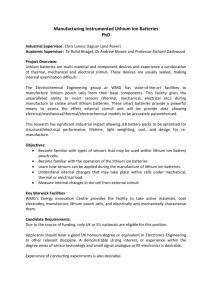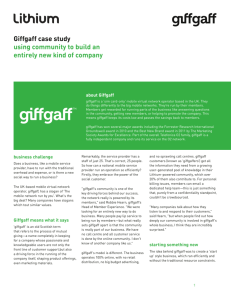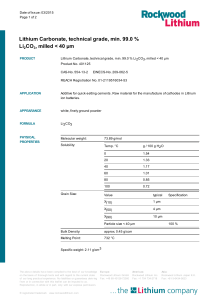Lithium in the Cosmos
advertisement
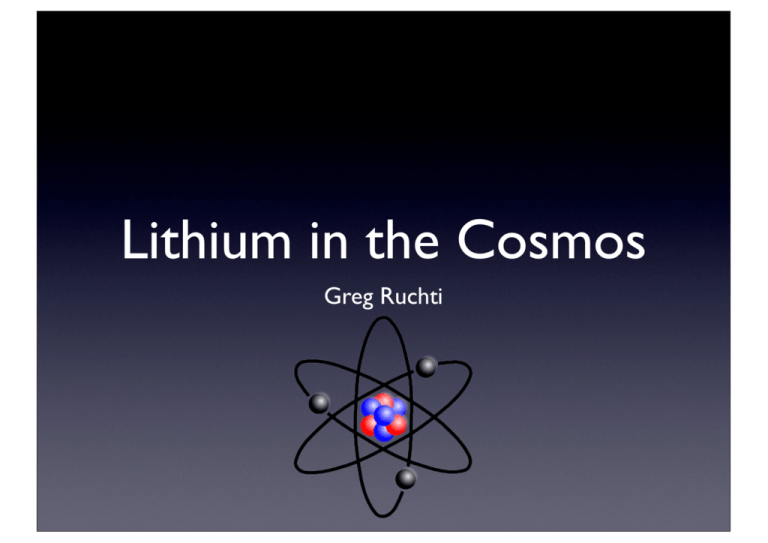
Lithium in the Cosmos Greg Ruchti Outline • Why is lithium Interesting? • The cosmic lithium problem. • The lithium problem in giants. Why is lithium interesting? • Important for our understanding of the universe. • • • • 7Li is one of four isotopes synthesized immediately after the big bang. A primordial abundance can be predicted using measurements of the cosmic microwave background. Important for our understanding of stellar interiors. • • 7Li is produced during nuclear burning inside a star. The abundance of Li can be used to constrain the processes that take place inside a star. However, lithium is a problem... The Cosmic Lithium Problem Big Bang Nucleosynthesis • BBN describes the production of the lightest elements - D, 3He, 4He, and 7Li - about 1 second to 3 minutes after the big bang. • The “Standard BBN” refers to the marriage of the Standard Model of particle physics with ΛCDM cosmology in that: • • Gravity is governed by General Relativity. • The microphysics is that of the Standard Model of particle physics. • The Standard Model particle content is supplemented with dark matter and dark energy. The universe is homogeneous and isotropic. Light Element Production • Number of key reactions in BBN much smaller as compared to stellar nucleosynthesis. • All important reactions have been measured in the laboratory. • Light element formation depends crucially on the relative amounts of baryons and radiation. • In standard Big Bang theory, the only free parameter controlling primordial nucleosynthesis is the baryon-to-photon ratio, ƞ. 24 Primordial Lithium Problem The Advent of WMAP • • The Wilkinson Microwave Anisotropy Probe (WMAP) makes ultra-precise measurements of the anisotropies of the cosmic microwave background. One of the most robust measurements is that of the cosmic baryon density, Ωbh2 = 2.258x10-2 (Larson et al. 2011). • This corresponds to ƞ = 6.19x10-10 with an uncertainty of only 2.4%. • Can then predict the primordial abundances of D, 4He, 3He, and 7Li. • A(7Li) = 2.7 for log A(H) = 12. 4He D 3He 7Li Cybert et al. (2008) Figure 2: BBN theory predictions for light nuclide abundances vs baryonto-photon ratio η. Curve widths: 1σ theoretical uncertainties. Vertical band: WMAP determination of η. Measuring the Primordial Abundances • Deuterium can be measured at high redshift in neutral hydrogen gas clouds seen in absorption along sight-lines to distant quasars. • 4He • 3He • 7Li can be measured in emission from H II regions in nearby metalpoor galaxies. can only be measured in the Milky Way interstellar medium -not primordial! is measured in stars. Measuring Primordial Li • Low-mass stars can be as old as the Universe. • The chemical composition of the atmosphere of a dwarf star is a good witness of the matter which formed the star. • In other words, the chemical composition of the atmosphere does not “change” with time. • Can measure the abundance of Li using absorption lines in the spectrum of the star. H→He Lithium is fragile! But... Lithium is a very fragile element • Ok, I lied... Lithium is readily destroyed in stars like • destroyed : if mixing between the atmosphere and these hot layers lithium is destroyed little by little in the atmosphere convection the Sun. • 7Li ! 6Li If mixing between the atmosphere and 6 T>2.5 inner hot 10 layers,K! Li destroyed. ! 7Li: 7 4He Li + p6 K→ T > 2.5x10 7Li + 4He $ + p → 4He + 4He 6 K! T>2.0 10 6Li: T > 2.0x106 K 6Li+D→4He + 4He ! 6Li + D → 4He + 4He 6Li+p→4He + 3He ... $$ 6Li Sun + p → 4He + 3He Paris, 2012, Lithium in the Cosmos r = 3/4 R! 22x10 1066 KK! 8 Metal-poor stars the answer • Warm, metal-poor stars (turn-off stars: T>5900 K) mixing is not as deep as the Sun. In warm metal-poor Convection does not reachstars • temperatures at which (turnoff stars: Teff > 5900K) Lithium is burned. mixing is not as deep as in solar Lithium is preserved • type stars and (temporarily). Metal poor star lithium is preserved abundance of Li . • So, a priori, in old metal-poor turnoff stars = abundance of Li in primitive Galactic matter. 2.5 1066KK! 2.5x10 A priori : Abundance of lithium in old metal-poor turnoff stars = Abundance of lithium in the primitive galactic matter Primordial Lithium Problem Cybert et al. (2008) And here lies the problem... 27 SDSS102915 3-4x Lower than BBN! Spite Plateau -5< [Fe/H] <-2.0 Excellent agreement for D/H, but 7Li/H way off!! Blue: Prediction Likelihood Yellow: Observational Likelihoods Figure 5: Comparison of BBN+WMAP predictions and observations, from (30). Dotted: Plotted are likelihoodObservational distributions for light likelihoods nuclide abundances. Blue curves: theory likelihoods predicted for standard BBN using the cosmic baryon density for different abundance analyses. determined by WMAP(63). Yellow curves: observational likelihoods based on primordial abundances as in §2.2. Dotted curves: observational likelihoods for Paris, 2012, Lithium in the Cosmos 12 Could predictions be wrong? Primordial Lithium Problem • • BBN theory predictions have sharpened due to new nuclear data. • Uncertainty on 3He(α,γ)7Be reduced to ~7% (Cyburt et al. 2008). • Resonances which have evaded experimental detection -- important or no? (e.g., Cybert & Pospelov 2009) 1: n → p e ν 2: n(p, γ)d 3: d(d, p)t 4: d(p, γ)3 He 5: d(d, n)3 He 6: 3 He(n, p)t 7: t(d, n)4 He 8: d(d, γ)4 He 9: 3 He(d, p)4 He 10: t(α, γ)7 Li 11: 4 He(α, γ)7 Be 12: 7 Be(n, p)7 Li ∗ 13: 7 Be + d → 9 B ∗ 14: 7 Be + 3 He → 10 C WMAP now has 7 years of data. • Uncertainty in cosmic baryon density reduced to 2.4% (Larson et al. 2011). 1H 1 2 10 C 14 ' '(# # ) ' ' 9B ' $# # # ) '# '#13 7 Be % 12 $ # # % & % 11# 7 Li # # $ # # # # # 3 He 9 " 4 He # 10 8 # !!%# $ ! # # 4 5 %6 7 # #% & " 2d " 3t 3 ! 1n Fields (2012) Figure 1: Simplified BBN nuclear network: 12 normally important reacti shown in blue, and proposed/tested new reactions in red. Two solutions... • Lithium destroyed before the formation of the old metal-poor stars. • Lithium destroyed during the lifetime of old metal-poor stars. Dark Matter Decay • Standard BBN is very robust, which implies need to go beyond the Standard Model. • If dark matter is a relic particle created in the early universe, it must be non-baryonic and demands physics beyond the Standard Model. • Dark matter present during BBN, but non-relativistic and weakly interacting → weakly interacting massive particles (WIMPS). • WIMPs today are likely the stable endpoints of a decay cascade. • Decays are model-dependent, but produce Standard Model particles which interact with surroundings. • If decays occur during (or after) BBN, the interactions can change light element abundances. Supersymmetric Dark Matter • Supersymmetry provides well-motivated candidates for decaying dark matter. • Supersymmetry requires opposite-statistics partners for every known particle. • The lightest supersymmetric partner (LSP) is the stable end product of the decays of highermass supersymmetric particles. • • Thus, the LSP is a candidate for dark matter. • These decays could lead to the depletion of the primordial 7Li. • Some models have been found, which appear to work if the gravitino is the LSP (Feng et al. 2004, Jedamzik et al. 2006) Supersymmetric scenarios demand that particle decays occur. Stellar Li Depletion • Atomic Diffusion: a one-way ticket to the destruction of Li. • • Slow gravitational settling of elements below the convective zone. However, diffusion too efficient. diffusion atmosphere Metal poor star T>2.5 106 K! Atomic settling convec It "is alwa can only motion ei turbulenc If diffusion is efficient, the lithium abu a metal-poor dwarf decreases with tim Characteristic time scale: 1 Atomic Diffusion • Li depletes too quickly. • Needs an additional ad hoc turbulence parameter (Richard et al. 2005, Korn et al. 2006). • Work still being done to constrain the turbulence parameter using stellar clusters. Diffusion + Turbulence Pure Diffusion pure diffusion Teff > 5900K -2.8 <[Fe/H]< -2.0 depletion computed after 13.5Gyr Paris, 2012, Lithium in the Cosmos 18 To Summarize... • The discrepancy between the WMAP predictions for the primordial Li abundance and that measured in stars still unexplained. • • New theories perhaps closing the gap. • • Supersymmetric dark matter could decay, which depleted the primordial 7Li in the galactic matter. • The large hadron collider will be able to probe supersymmetry and may give indications for the existence of the LSP. • Stay tuned for results from full LHC 2011/2012 data sets! Stars are depleting Li in their atmospheres (diffusion). • More modeling and tests using globular cluster stars are needed to constrain the turbulence parameter for atomic diffusion. • Other possibilities: e.g., internal gravity waves. Measure Li in low-metallicity gas (e.g., in the SMC; Howk et al. 2012). The Lithium Problem in Giants Li beyond the subgiant branch • As a star moves beyond the SGB, convective depletion brings A(Li) down by more than one order of magnitude. • Li produced in interior, but immediately destroyed. • Li in surface layers burned away by convective dilution. WHY Lithium Giants are unusual? n( Li) * A( Li) log n( H ) 12 Gray, David. The Observation and Analysis of Stellar Photospheres, Cambridge University Press, 2005 A(Li) <0.5 is typical for stars on the upper red giantGray branch(RGB) (Lind et al. 2009). (2005) But, Li-rich giants exist! 5 4 A(Li) NLTE 3 Li-rich giant in M3 WMAP 2 Spite Plateau 1 0 −1 −2 0 Kraft et al. (1999) 1 2 3 4 log (L LSun) Ruchti et al. (2011) And so, we have another Li problem... • Li-rich giants have been discovered in both the field and in clusters (e.g., Kraft et al. 99, Charbonnel & Balachandran 2000, Monaco et al. 2011, Ruchti et al. 2011). • New discoveries in the dwarf spheroidal galaxies in the Local Group (Kirby et al. 2012). • They appear to represent about 1% of all giants (Brown et al. 1989) short-lived phase?? • Stars can produce Li in their late-stages of evolution via the Cameron & Fowler (1971) mechanism Kumar et al. (2011) Cameron-Fowler Mechanism • Takes place in intermediate-mass AGB stars. • At this stage, outer convective envelope is in contact with the H-burning shell where 3He is being produced by proton-proton reactions. • The 3He is burned to 7Be via 3He(α,γ)7Be under convective conditions. • The 7Be is then swept up to the stellar surface and decays to 7Li by electron capture. • • 7Li Convective Envelope will then survive for a short period. However, some Li-rich giants are low-mass and not evolving on the AGB!! H-burn Shell Li-production in lowmass stars • The convective envelope and H-burning shell are not in contact in low-mass stars. • Standard mixing not enough. • Non-canonical “extra mixing” mechanism needed to connect the two zones. • Physical mechanism not understood -- many theories for induced “extra mixing”. Extra Mixing Core H-burning Shell Convective Envelope Extra Mixing • Efficient extra mixing postulated to occur at the luminosity bump of the red giant branch (Gratton et al. 2004, Charbonnel & Balachandran 2000). • Thermohaline mixing (Charbonnel & Zahn 2007). • Magneto-thermohaline mixing -magnetic buoyancy (Denissenkov et al. 2009). • Rotation induced mixing -- 50% of Lirich giants may be rapid rotators (vsini > 8km/s) (Drake et al. 2002). • Cool Bottom Processing (Sackmann & Boothroyd 1999). • Mass loss (de La Reza et al. 1996,97). Other Possibilities • • Giant star in a close binary system with more massive AGB star. • AGB star has undergone the Cameron-Fowler Mechanism. • Li-rich material is transferred to the low-mass giant. • Scenario is certainly feasible, however, recent studies have shown that not all Li-rich giants are in close binary systems. Ingestion of planet or brown dwarf. • Angular momentum may induce extra mixing which could drive the Cameron-Fowler mechanism (Denissenkov & Weiss 2000). • Metal-poor giants less likely to host planets (Fischer & Valenti 2005). • Lack of enriched Be (Melo et al. 2005) unlikely to be main driver of Li-production in the Li-rich giants. A Caveat Ruchti et al. (2011) • Some mixing mechanisms are accompanied by the mixture of other elements to the surface (e.g, C, N, O). • Li-rich giants appear to show similar abundance ratios to other “Li-normal” giants. • Implies that extra mixing event cannot affect the other elements. • Or, mixing event is short-lived and occurs in all giants? (de La Reza et al. 1996, Gonzalez et al. 2009) Large points: Li-rich Small pluses: Li-normal To Summarize... • Lithium is expected to be destroyed as a star evolves beyond the subgiant branch. • However, Li-rich giants exist. • Require non-canonical extra mixing (internally or externally driven) to produce lithium on the stellar surface. • The next step: asteroseismology. “- It looks like grandma’s mood is so much better today!” “- ‘course son...Lithium never fails.”
